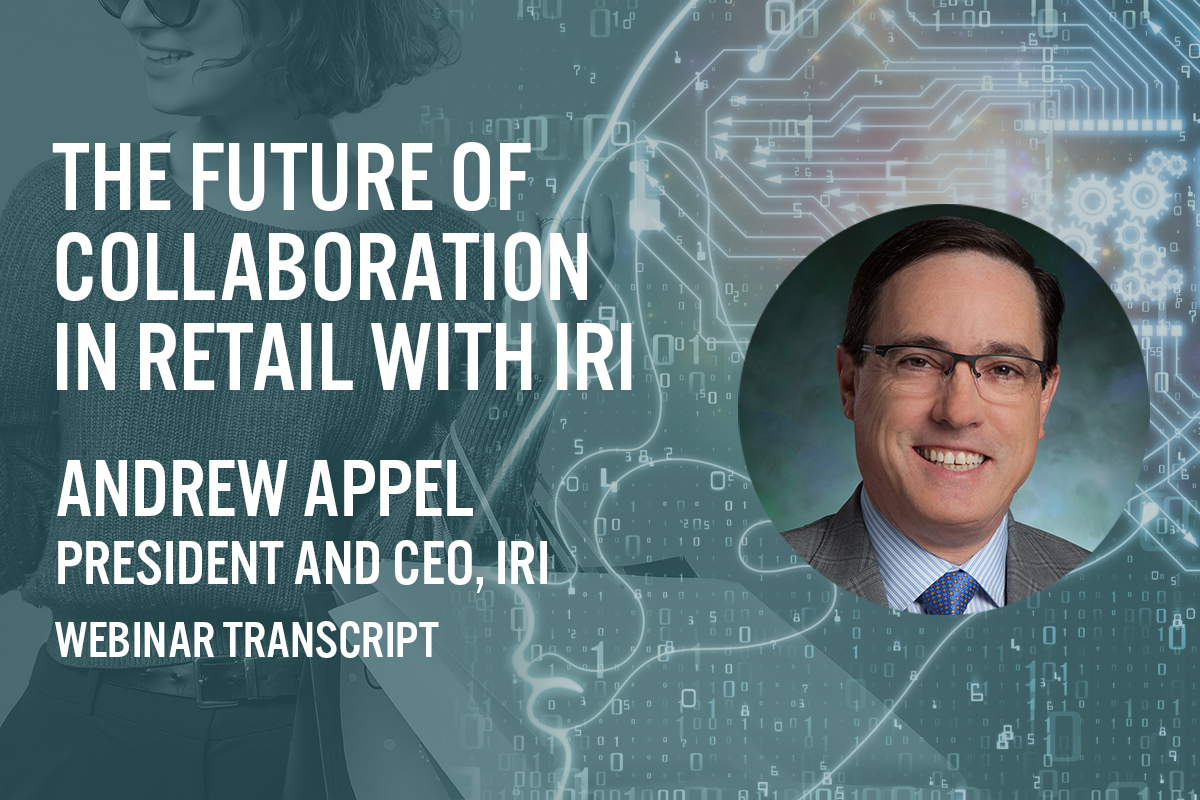
DIpil Das
We present an edited version of our conversation with Andrew Appel, President and CEO at data analytics firm IRI in a webinar held on May 26, 2020. The webinar was hosted by Deborah Weinswig, CEO and Founder of Coresight Research.
 Andrew Appel is President and CEO of IRI. He joined IRI in June 2012, having previously held a number of senior leadership positions for Chicago-based professional service firms.
As COO at Aon, Appel developed and implemented a successful revenue growth plan for the company. He also led the team responsible for the $5 billion acquisition of Hewitt, solidifying Aon's leading position in human resource consulting and outsourcing. Prior to this, Appel was CEO of two of the firm's three global divisions.
Andrew Appel is President and CEO of IRI. He joined IRI in June 2012, having previously held a number of senior leadership positions for Chicago-based professional service firms.
As COO at Aon, Appel developed and implemented a successful revenue growth plan for the company. He also led the team responsible for the $5 billion acquisition of Hewitt, solidifying Aon's leading position in human resource consulting and outsourcing. Prior to this, Appel was CEO of two of the firm's three global divisions.
 Andrew Appel and Deborah Weinswig
Andrew Appel and Deborah Weinswig
Source: Coresight Research [/caption]
 Andrew Appel is President and CEO of IRI. He joined IRI in June 2012, having previously held a number of senior leadership positions for Chicago-based professional service firms.
As COO at Aon, Appel developed and implemented a successful revenue growth plan for the company. He also led the team responsible for the $5 billion acquisition of Hewitt, solidifying Aon's leading position in human resource consulting and outsourcing. Prior to this, Appel was CEO of two of the firm's three global divisions.
Andrew Appel is President and CEO of IRI. He joined IRI in June 2012, having previously held a number of senior leadership positions for Chicago-based professional service firms.
As COO at Aon, Appel developed and implemented a successful revenue growth plan for the company. He also led the team responsible for the $5 billion acquisition of Hewitt, solidifying Aon's leading position in human resource consulting and outsourcing. Prior to this, Appel was CEO of two of the firm's three global divisions.
Changes in Consumer Shopping Behaviors
What are some of the changes that you are seeing in terms of the channels that people are shopping through? For the most part, we have seen a migration to large-format, big-basket trips. Up until the last couple weeks, consumers effectively wanted to do one trip a week, and so the basket sizes were up and the larger-format stores were doing better—when we look at our data by format, for example. It is interesting that the small grocers are doing just as well as the large ones. The mom-and-pop, small, local grocer has been doing okay, as best we can tell. I think where it is the primary shopping destination for the family, we are continuing to see that growth rate be very high. That could shift as the environment shifts, but for the last 12 weeks, we've continued to see a rotation toward traditional grocery and e-commerce. The $64,000 question is how much of stockpiling was consumption versus pantry stocking. I think our data would show that people mostly bought two purchase cycles of home stuff in that first two weeks—so if the average purchase cycle for laundry is six weeks, it is now 12, something like that. There was a doubling up in a lot of homecare categories like that. What do you think are the longer-term implications for food outside the home? Within the past two years, out-of-home has passed grocery store-related sales. The question is how much of that will cycle back. You would expect that if all consumption moved from out-of-home to in-home, there would be a 25–30% increase in grocery sales. We are seeing some return back to normal volumes—call it 10–15% above, all over the world where we are tracking each market. But it is going to take a while before it settles back to what it was like for the first two months of the year for the last 10 years. I think there are many more forces ultimately leaning toward increased consumption at home: recession, social distancing, restaurant bankruptcies. I would say, in a best-case scenario, there would be 50–60% of the restaurant activity that there was four months ago in a year from now. If we think about past recessions and how the consumer behaves, what have we seen so far, and what do you think we will see in the future? There are three trends, which we saw in the 2008 recession:- Private label does better.
- Really strong, high-market-share brands do fine.
- Treats and snacks and impulse do well—because the definition of treating yourself is no longer going out to restaurants.
 Andrew Appel and Deborah Weinswig
Andrew Appel and Deborah Weinswig Source: Coresight Research [/caption]
Retaining Customers in a Challenging Environment
How do you think retailers’ assortments will play out?- We are generally seeing assortment reductions from the big retailers, in order to basically fulfill demand.
- I think one of the big challenges for the manufacturers is retail relevancy.
- I think we are going to very quickly migrate to simplified assortments, the ability to deliver product in this environment and then a huge opportunity for retaining new buyers and not losing loyal buyers.